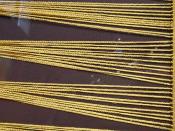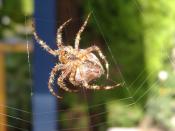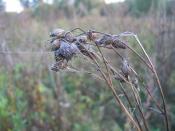Walking Into Spider Webs
Spider silk has intrigued many groups ranging from the medical field, to the military, to individual industries. Why would we want to use biotechnology to create our own spider webs? For starters, the fiber is very elastic: during wind gusts, webs can stretch 40% of its original length and return to its natural shape. The elasticity is 30% more than the strongest nylon (the silk will only break at 3-4 times its length). However, the elasticity combines with the strength of the silk in order to create a winning combination, which makes it stronger than a Kevlar vest. Even more interesting, is the wasted elements and taxing process we put into making Kevlar versus the spider's natural ability to do so without harming the environment.
In order to use biomimtech methods, first, we need the prototype to base our synthetic spider web on. The silk is originally in liquid form, and produced through silk glands in the spider.
Before it is released from the spinneret it hardens. The silk itself is composed of 50% of polymerized protein, called fibroine.
Since spiders cannot be farmed like worms (spiders are very territorial and aggressive), we are left to biomimic their creation. So far, one method has been formulated:
Lazaris et al. describe the production of a number of dragline silk proteins in mammalian cells and show, for the first time, that harvested recombinant proteins can be spun into strong, lightweight fibers. cDNA clones encoding the two protein components of dragline silk from the spider species Araneus diadematus and Nephila claviceps were expressed in two cell lines, bovine mammary epithelial cells and hamster kidney cells. Both cell lines secreted soluble silk proteins in large amounts, which could easily be collected. These proteins showed molecular masses of between 60 and...


